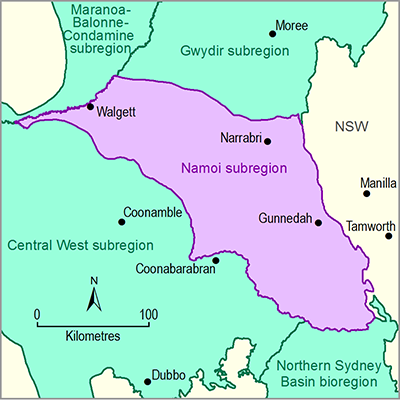Overall, hydrological modelling predicted a 2299 km2 area under additional drawdown and 20% (7014 km2) of the assessment extent is within the (combined surface and groundwater) zone of potential hydrological change as a result of the eight modelled additional coal resource developments in the Namoi subregion. This has the potential for cumulative impacts due to the location of a number of new developments in close proximity to each other as well as interaction with baseline coal resource development. As a result, there is overlap of groundwater drawdown from multiple developments. This drawdown and direct interception of overland flow potentially leads to more low flows, and fewer high flows and overbank events. There are 5521 km of streams in the zone of potential hydrological change and we were unable to interpolate to 3629 km of streams. For those areas with sufficient data, there is an increase in more than 3 zero-flow days per year predicted for 1678 km of streams. Predicted changes in the flow of the Namoi River are minimal. However, Back Creek, Merrygowen Creek and Bollol Creek are very likely to experience changes in their flow, particularly with respect to the change in the number of zero-flow days. The changes in the streamflow may lead to potential impacts on the water-dependent ‘Floodplain or lowland riverine’ and ‘Non-floodplain or upland riverine’ landscape groups. Where modelling was available some areas of Maules Creek, Back Creek and Bollol Creek within the ‘Floodplain or lowland riverine’ landscape group are ‘more at risk of ecological and hydrological changes’ than other streams in the assessment extent due to additional coal resource development. There are areas within the zone of potential hydrological change where the lack of surface water modelling prevented a quantification of the risk to ecosystems. These require more work to assess the potential for impact due to additional coal resource development to ecosystems and associated assets. There are also potential impacts on ecological assets that utilise the potentially impacted landscape groups, as well as groundwater economic assets. The alluvium zones that have the greatest area potentially impacted are the Upper Namoi Alluvium zones 4, 7 and 8 while the Lower Namoi Alluvium has less than 1 km2 that is within the groundwater zone of potential hydrological change. The hydrological changes intersect with only a limited number of sociocultural assets from the asset register (Bioregional Assessment Programme, 2017; companion product 1.3 for the Namoi subregion (O’Grady et al., 2015); Bioregional Assessment Programme, Dataset 1).

Product Finalisation date
- 3.1 Overview
- 3.2 Methods
- 3.3 Potential hydrological changes
- 3.4 Impacts on and risks to landscape classes
- 3.4.1 Overview
- 3.4.2 Landscape classes that are unlikely to be impacted
- 3.4.3 'Floodplain or lowland riverine' (non-Pilliga) landscape group
- 3.4.4 'Non-floodplain or upland riverine' (non-Pilliga) landscape group
- 3.4.5 Pilliga riverine (upland and lowland)
- 3.4.6 Potentially impacted landscape classes lacking quantitative ecological modelling
- References
- Datasets
- 3.5 Impacts on and risks to water-dependent assets
- 3.6 Commentary for coal resource developments that are not modelled
- 3.7 Conclusion
- Citation
- Acknowledgements
- Contributors to the Technical Programme
- About this technical product
